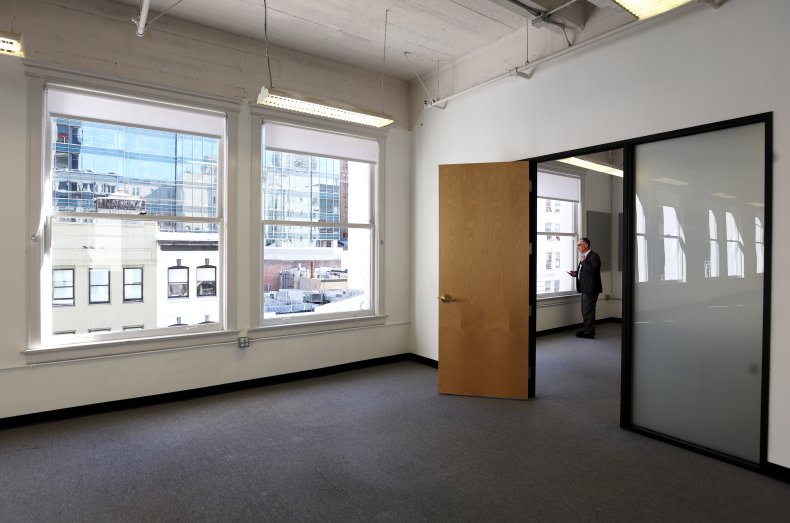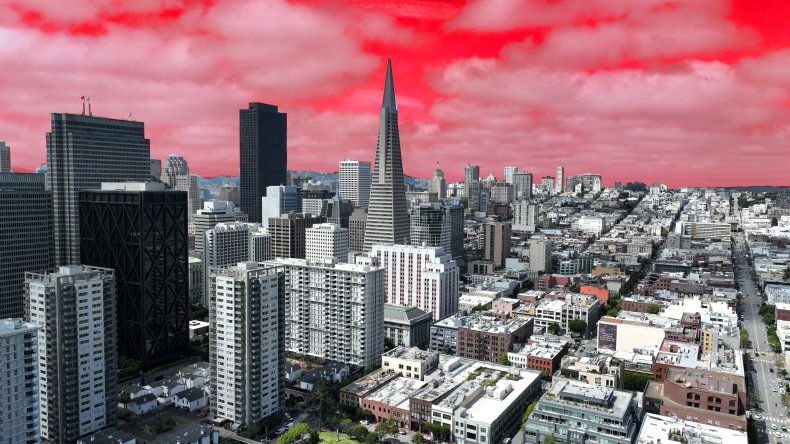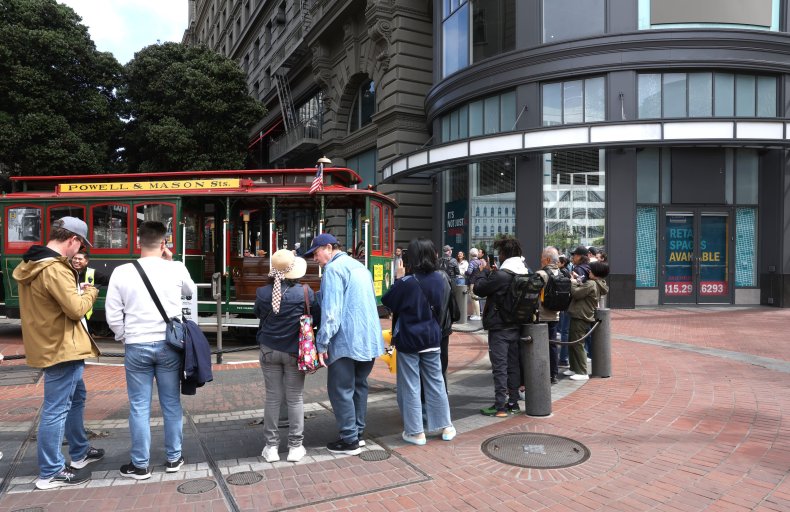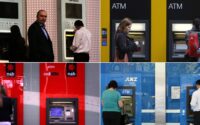San Francisco’s Decline is a Warning to Other American Cities
Struggling with rampant homelessness, a drug crisis, surging crime and several business closures, San Francisco is no longer the thriving city it used to be. Its decline in recent months has led some to say the city “is dying”—especially as its citizens move elsewhere.
A quarter of a million people have reportedly fled the Bay Area since the beginning of 2020. According to U.S. Census estimates, San Francisco’s population dropped by 7.2 percent between 2020 and 2021 and by 0.3 percent between 2021 and 2022.
This exodus, sparked by the COVID-19 pandemic and the change in working habits that came with it, continued in 2022 even as the health emergency drew to a close. While life in other big cities started getting back to normal, San Francisco and the Bay Area continued to shrink, although at a slower pace.

Justin Sullivan/Getty
It is wealthier people who are leaving San Francisco, too. Lee H. Ohanian, a professor of economics and director of the Ettinger Family Program in Macroeconomic Research at the University of California, Los Angeles (UCLA), wrote that this exodus caused a $7 billion net income loss within the city.
But how did the City by the Bay get there—and could a similar decline affect other major American centers?
A ‘Broken Network’ In the City
“The pandemic really changed the pace of the city and, to a certain extent, the lifeline of the city,” Lu Chen, San Francisco resident and senior economist at Moody’s Analytics, told Newsweek.
San Francisco, with its proximity to Silicon Valley, had grown in the past few decades to become one of the country’s main tech hubs. Young, skilled workers flocked to the city in this modern gold rush as giants like Google, Apple, Facebook and Twitter set up their headquarters there.
But everything changed when the pandemic hit. Many San Francisco tech workers moved further out to cheaper cities, while many outside of the city decided against relocating there.
“We started seeing the caller cities—smaller cities which are close enough to San Francisco—attract more people,” Chen said. “These cities are more affordable, they have lower cost of living, they have equally nice weather, they have a larger lot, bigger houses, newer houses, nice neighborhoods, good school districts, safer, and are easier to commute.”
And tech workers appear to want to stay there. Because despite the end of the pandemic and its lockdown restrictions, many have chosen not to return to their offices. This has left many buildings in San Francisco partially or mostly empty, harming retail and causing a fracture in the city and the way it used to work, said Chen.
The office vacancy rate in San Francisco is about 30 percent—or about 35 million square feet, Colin Yasukochi, an executive director at commercial real estate firm CBRE, recently told NBC.

Justin Sullivan/Getty Images
“If we look at the city as a whole, you have retail, offices, and residential all supporting each other. Now there’s actually a broken network among different linkages of commercial properties,” Chen said.
Ted Egan, San Francisco’s chief economist, agrees. “High office vacancy is harming the city’s economy, beyond its impact on commercial real estate itself,” he told Newsweek.
“It is contributing to a loss of business tax revenue to the city, and a loss of ridership for local transit agencies. It has also harmed small businesses located downtown, who don’t have the same foot traffic from office workers eating lunch, meeting after work, or shopping during the day. It is also curtailing business tourism.”
San Francisco’s booming housing sector has also suffered a hit in recent months, with the city being second only to Austin, Texas, for the rate at which home prices have fallen.
In April 2022—the zenith of the pandemic-era housing market boom—the median sale price of a home in San Francisco was $1.6 million, according to Redfin—11 percent more than the previous year. In April 2023, the median sale price of a home in San Francisco had dropped to $1.3 million, Redfin figures showed, 17.3 percentage points below the level reported a year before.
More Than A Tech Workers’ Exodus
There are other issues which might have prompted some people to abandon the city—like the fentanyl crisis gripping the Tenderloin district, where overdose deaths have surged since the beginning of the year.
Gen-Z activist Darren Stallcup, who has lived in the Tenderloin all his life, told Newsweek that he feels “traumatized” by the number of people who’s seen dying in the streets of his neighbourhood.
“I was born and raised in the San Francisco Bay area, this is my home,” Stallcup, who regularly records with his phone camera and then shares with the world on Twitter, said. “And I’ve seen my home go from being the cultural capital of the world to the technological capital of the world and then, somewhere between the homeless crisis and the pandemic, we’ve become the fentanyl capital of the world.”
Between January and March of 2023, 200 people died of overdose in the Tenderloin, with 159 deaths being caused by fentanyl—more than during the same time frame the year before. On a national level, fentanyl is estimated to have killed over 100,000 people in 2021 alone.
The San Francisco’s Department of Public Health (SFDPH) declined an interview request from Newsweek, but shared a statement saying that the department “is working to prevent deaths caused by accidental drug overdoses through multiple interventions.”
In order to do that, SFDPH is increasing access and availability of medications for addiction treatment and has opened several recovery centers in the city in the past two years, it said. The department also has street care teams dedicating to reach people most at risk of overdose.
But the fentanyl epidemic is just one of many crises facing San Francisco at the moment. While homelessness remains high—with an estimated 7,754 homeless people as of 2022—the city is also facing an increase in crime, which has been linked to the closure of several businesses in the city.
In 2021, Target announced reduced night hours in some of its San Francisco stores because of the city’s rise in shoplifting and thefts. Later in the same year, Walgreens reported the closures of five of its stores in the city because of a rise in “organized retail crime.”
In May, online news website SFGATE reported that T-Mobile had closed its flagship store in San Francisco’s Union Square the month before. In April, Whole Foods shut its downtown store after just a year of business, with bosses saying they were unable to “ensure the safety” of their staff in the city. Nordstrom followed suit, leaving the city central district earlier in May.
Out of 203 retailers present in the city’s Union Square area as of 2019, over 90 have closed since the beginning of the pandemic, as reported by the Daily Mail.

Justin Sullivan/Getty Images
There’s been a 5 percent increase in homicide in the city between January and April this year compared to the same period a year prior, while robberies have risen by 16.1 percent, according to San Francisco Police Department’s crime dashboard. Other crimes, like rape and assault, have significantly dropped in the same period.
San Francisco’s Mayor London Breed, a Democrat, has announced several efforts to tackle crime, homelessness, and drug addiction in the city since taking office in 2018. However, during her time in office, she’s been criticized by both conservatives and progressives, who have accused her, respectively, of being too radical or not liberal enough.
In 2021, Breed declared a state of emergency in the Tenderloin to tackle the fentanyl epidemic there, a move that allowed her to increase police budgets and ramp up services to addicts and mentally ill people living in the streets. The measure was in break with liberals, who have called for defunding law enforcement.
Breed is running for re-election to a second term in office in November 2024. Newsweek contacted the office of the mayor for comment but did not receive a timely response.
Is This The End Of San Francisco?
Despite the city’s troubles, experts are not ready to proclaim the city dead.
“We are seeing a lot of private and public partnership to save the city’s destiny, and that is a good move,” Chen told Newsweek. “We are seeing the city removing a lot of barriers for converting the commercial use properties into residential, creating the mixed-use neighborhood of combining retail/office/apartment and single-family housing together. That is a very important step in the right direction.”

Getty/Newsweek
California assembly member Matt Haney, a Democrat, agrees that the city can be saved if it’s able to transform itself—and its vacant skyscrapers—quickly.
“The most urgent thing downtown San Francisco needs to do is to adapt quickly, we need to turn many of these empty office buildings into housing and we need to attract the innovative economies of the future, including climate tech, A.I., and biotech,” he told Newsweek.
“All of that can happen and will happen if we adapt quickly and address the other social and safety challenges downtown. It’s hard to keep downtown safe when it’s empty. It’s also hard to fill it if it’s unsafe. So we need to do both.”
But Egan thinks that converting empty office spaces might not be such an easy operation.
“One of the current challenges with converting office space in San Francisco is the high cost of construction, and the fact that the market for alternative uses—housing, hotels, and retail—are also depressed because of the decline in demand for offices,” he said.
“Downtown housing, for example, has dropped in value because a large piece of that demand came from office workers who wanted a short commute. That demand has diminished because of remote work,” he added. “What I think is most likely is an eventual re-configuration of most of the space for other, hybrid office uses.”
Egan is optimistic on other fronts, like that of business closures, which he expects to stop, “unless we see a recession.”
“Taxable sales downtown—which is our best measure of commercial activity—has been growing steadily, if slowly,” he said.
But not everything is on its way to recovery in the city. In terms of housing, Laura Ratz, another economist at Moody’s Analytics, said San Francisco’s best days are likely to be behind it.
“For the whole of its recent history, San Francisco has been an incredibly expensive place to buy a home and to live and to do business—and right now we’re seeing some correction,” she told Newsweek. “I think that the high-flying days of the past two decades are definitely in the rearview for San Francisco.”

Justin Sullivan/Getty Images
A Warning To Other U.S. Cities?
The conditions that brought on San Francisco’s decline are unlikely to befall another American cities, according to experts.
“I think that San Francisco has its unique characteristics,” Chen said. “San Francisco is the only city so far among all major American metros which hasn’t fully recovered from the pandemic.
“Other major cities, like New York and Washington, D.C., had seen similar level of outmigration in 2021 but are now having a sizeable recovery, with an inflow of population,” she added.
Ratz agrees, saying that San Francisco is “in a lot of way its own animal,” but also believes that a lot of metro areas west of the Rockies are going to see same sharp price corrections that the city has experienced in the latest months, including Phoenix and Seattle, though she wouldn’t “put them quite in the same category.”
Despite San Francisco presenting a unique case, the city’s recent slump still serves as a cautionary tale for others.
For Haney, the reason behind San Francisco’s downtown decline is that the city, years ago, decided to put all its eggs in one basket: building commercial and office spaces during the tech “gold rush.”
“The city built a lot of commercial office space and not much else downtown,” Haney said. “And that’s a problem, because now downtown is empty, very few people live downtown and there are not diverse uses [to these empty buildings] that can provide the resilience we need as our economy changes.”
[ad_2]
Source link

